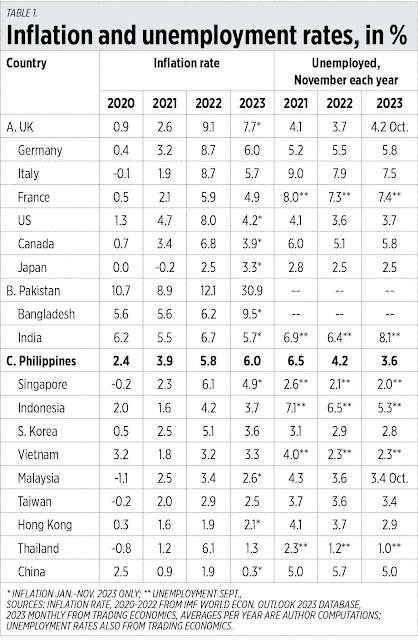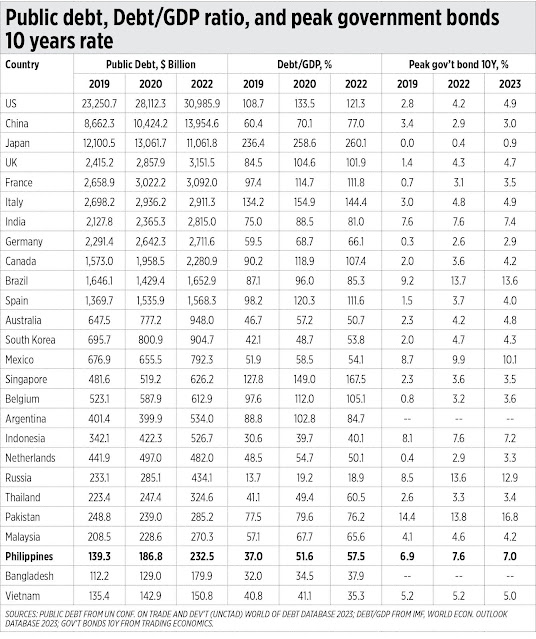(1) DoE eyes implementation of higher biodiesel blend in July
Sheldeen Joy Talavera January 2, 2024 | 12:31 am
https://www.bworldonline.com/top-stories/2024/01/02/566223/doe-eyes-implementation-of-higher-biodiesel-blend-in-july/
"Bienvenido S. Oplas, Jr., president of Minimal Government Thinkers, said higher biodiesel blend could drive food prices up.
“Corn and other crops should feed people and animals, not cars. It will have an adverse impact on food prices and could worsen instead of mitigate high food inflation,” he said in a Viber message.
Both analysts said the higher biodiesel blend might not necessarily lead to lower local oil prices because these still depend on the global market.
“World oil prices fluctuate up and down, but biodiesel mandates are permanent, with permanent price distortions,” Mr. Oplas said."
(2) Market for AS power enters pilot operations
Sheldeen Joy Talavera January 3, 2024 | 8:25 pm
https://www.bworldonline.com/economy/2024/01/03/566770/market-for-as-power-enters-pilot-operations/
"...Asked to comment, Bienvenido S. Oplas, Jr., president of Minimal Government Thinkers said that the reserve market will expand power supply by encouraging generation companies (gencos) to build more power plants.
“Most of new generation capacity will be contracted by DUs (distribution utilities), RES (retail electricity suppliers) and ECs (electric cooperatives). But some generation capacity will be for reserves by the system operator or embedded with DUs themselves,” Mr. Oplas said in a Viber message.
“The market for new capacity has expanded so more gencos will be encouraged to put up more new power plants,” he added."
(3) Analysts laud Maharlika plan to invest in NGCP
Kyle Aristophere T. Atienza, Luisa Maria Jacinta C. Jocson and Jomel R. Paguian
January 8, 2024 | 8:42 pm
https://www.bworldonline.com/the-nation/2024/01/08/567577/analysts-laud-maharlika-plan-to-invest-in-ngcp/
"...It has been 15 years since NGCP got its franchise “and power deficiency problems still occur partly or largely due to transmission problems,” Bienvenido S. Oplas, Jr., president of think tank Minimal Government Thinkers, said in a Viber message.
“The MIC has political muscle and government signature that can match the political clout and muscle of NGCP being the only remaining private monopoly nationwide and has China government clout,” he said.
He added that removing the influence of China’s state-owned power company from NGCP is needed now more than ever amid souring Philippine relations with its neighbor over their South China Sea dispute."
(4) DoE plan must elevate energy security to top priority item, think tank says
John Victor D. Ordoñez January 7, 2024 | 7:40 pm
https://www.bworldonline.com/economy/2024/01/07/567304/doe-plan-must-elevate-energy-security-to-top-priority-item-think-tank-says/
"THE Department of Energy (DoE) should designate energy security as its main focus when it submits the Philippine Energy Plan (PEP) to Congress, according to a think tank.
“From power generation to transmission to distribution and supply, they all should harmonize into one goal — energy security,” Bienvenido S. Oplas, Jr., president of the free market think tank Minimal Government Thinkers, said in a Viber message....
Mr. Oplas said the DoE must ensure enough power is available to consumers to dispel worries of blackouts, especially after recent power outages in Panay.
“The DoE must consider power price fluctuations, surges and dips,” he said. “Which means the DoE should remain agnostic about where the energy comes from.”
(5) Meralco sees slight increase in generation charge for January
Sheldeen Joy Talavera January 9, 2024 | 12:05 am
https://www.bworldonline.com/corporate/2024/01/09/567567/meralco-sees-slight-increase-in-generation-charge-for-january/
"... Meanwhile, Bienvenido S. Oplas, Jr., president of Minimal Government Thinkers, expects a slight decrease due to lower coal prices in December-January and a lower Dubai crude price, to which the Malampaya gas price is pegged.
“But Meralco noted higher plant outage in WESM, so this may cancel out any potential price decrease,” he said in a Viber message.
Mr. Oplas said that he expects power rates to drop in the first quarter despite the onset of El Niño and upcoming dry months.
“This will affect and reduce hydro output, raise power demand, but since this is a mild El Niño, at least in Metro Manila and neighboring provinces, power demand will not rise as projected by alarmist models and scenarios,” he said."
(6) PHL-Indonesia deal may cushion coal, gas shocks
Kyle Aristophere T. Atienza January 10, 2024 | 8:42 pm
https://www.bworldonline.com/economy/2024/01/10/568081/phl-indonesia-deal-may-cushion-coal-gas-shocks/
Bienvenido S. Oplas, Jr., president of think tank Minimal Government Thinkers, noted that sharing of knowledge and technology in gas exploration and development between the two countries could be leveraged into a long-term partnership.
“Indonesia is not so much a gas exporter, Brunei is. But it’s good to mention that in the MoU because Indonesia’s gas potential reserves may not have been tapped yet; neither have those of the Philippines’,” he said in a Viber message.
Mr. Oplas said the deal also signals the continuation of the Philippines’ reliance on coal, which he said will remain a significant source of energy for many countries “because it’s abundant, cheap and easy to transport and store, and can provide dependable, reliable, 24/7 electricity except during maintenance shutdowns.”
“The so-called transition away from coal did not happen in Germany, did not happen in many other ‘decarbonizing’ countries,” he said, noting that coal accounted for 62% of Indonesia’s electricity generation in 2022.
Indonesia is a major coal exporter and the Philippines generated about 60% of total electricity from coal-fired plants in 2022 and 2023, he said.
(7) Regulator lifts suspension of the FIT-All collection
By Sheldeen Joy Talavera, January 19, 2024 | 12:32 am
https://www.bworldonline.com/top-stories/2024/01/19/569868/regulator-lifts-suspension-of-the-fit-all-collection/
"Sought for comment, Bienvenido S. Oplas, Jr., president of Minimal Government Thinkers, said that the resumption of FIT-All collection may lead to a slight increase in the cost of electricity, which may result in higher monthly power bills.
“This will raise the cost of electricity by 3.64 centavos/kWh, round off to four centavos/kWh starting February billing,” he said in a Viber message...
Households consuming 200 kWh may pay about P7.28 more, Mr. Oplas said, including value-added tax."
(8) ‘No-new-taxes’ pledge highlights balancing act between taxpayer relief, hitting revenue goals
January 28, 2024 | 8:41 pm
By Luisa Maria Jacinta C. Jocson
https://www.bworldonline.com/economy/2024/01/28/571647/no-new-taxes-pledge-highlights-balancing-act-between-taxpayer-relief-hitting-revenue-goals/
“No new or additional tax this year is a brilliant move,” Bienvenido S. Oplas, Jr., president of a research consultancy and of the Minimal Government Thinkers think tank, said in a Viber message, noting that tax hikes have short- to long-term inflationary impact.
Finance Secretary Ralph G. Recto has said he does not plan to introduce any new taxes, citing the need to minimize inflation and improve tax administration.
“The focus on improving tax administration is also good. High incidence of smuggling and illicit trade is a clear example of poor tax administration…so this is a good fiscal consolidation measure,” Mr. Oplas said.
(9) Renewables unlikely to top coal in PHL energy by 2025 — analysts
January 29, 2024 | 12:08 am
By Sheldeen Joy Talavera
https://www.bworldonline.com/corporate/2024/01/29/571634/renewables-unlikely-to-top-coal-in-phl-energy-by-2025-analysts/
“Intermittent wind-solar cannot and will not be able to replace or substitute coal generation unless we embrace and endure large-scale daily blackout,” Bienvenido S. Oplas, Jr., president of Minimal Government Thinkers, said in a Viber message last week....
Citing data from the Department of Energy (DoE), Mr. Oplas said that the combined power generation of wind and solar was 2,582 gigawatt-hours (GWh) or 2.6% of the total generation of 111,516 GWh in 2022, while coal accounted for 66,430 GWh or 57.7% of the total.
Mr. Oplas also noted the need for a significant addition to renewable capacity to meet economic growth and avoid frequent blackouts.
“Challenges to renewables especially intermittent wind-solar is that the Philippines is growing fast economically… We need at least 7-8 TWh (terawatt-hours)/year addition in 2024-2026… otherwise we cannot grow (GDP) 6% or more yearly as we will have frequent rotational blackout as demand keeps rising and supply is not catching up,” Mr. Oplas said.
(10) Storage, transportation named focus areas for hydrogen dev’t
January 30, 2024 | 10:02 pm
By Sheldeen Joy Talavera
https://www.bworldonline.com/economy/2024/01/30/572203/storage-transportation-named-focus-areas-for-hydrogen-devt/
"Asked to comment, Bienvenido S. Oplas, Jr., president of Minimal Government Thinkers, said that hydrogen as an energy source is “still very immature” and can be “costly and risky.”
“So we should not hurry going there, let the industrialized, technology-advanced countries start it first on a large scale before the Philippines and other developing countries adopt it,” he said in a Viber message.
Compared to hydrogen, Mr. Oplas said there are “very mature sources” such as nuclear, coal, natural gas, oil plants, and hydro power.
“Humanity has been using these for many years, their risks have been mapped and prepared for/anticipated.”

















